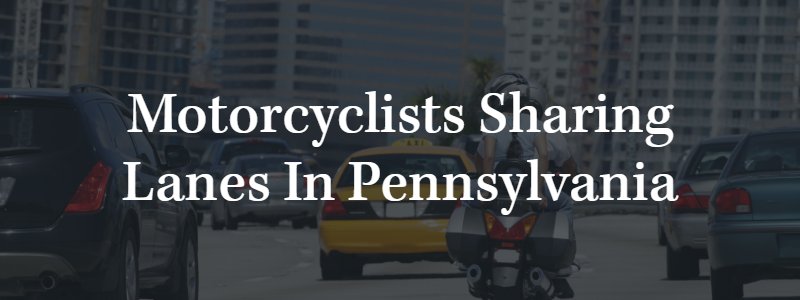If you have ever seen two motorcyclists ride side by side in a lane of traffic moving in the same direction, then you have seen lane sharing. Not to be confused with the controversial practice of lane splitting. As of this writing, California is the only state in the country that allows lane splitting. Even there, the state did not legalize the practice per se. They simply eliminated the traffic provision that prohibited lane splitting. State legislatures in the Commonwealth of Pennsylvania have discussed lane splitting many times over the years, and the law could change regarding this practice in the future. Sharing lanes, however, is legal in Pennsylvania.
What is lane splitting & how does it differ from lane sharing?
Lane splitting is the controversial practice of a motorcyclist traveling down the dotted center line between two lanes of traffic that are moving in the same direction. When a motorcyclist is lane splitting, they typically do this when traffic is moving very slowly or is stopped at a stoplight. The goal of the motorcyclist is to get to the front of traffic so they can get out of the congestion of vehicles. Lane sharing, on the other hand, is the practice where two motorcyclists ride side by side in the same lane.
Can motorcyclists share lanes in Pennsylvania?
You may have seen motorcyclists in this state ride side by side, a practice commonly referred to as riding two abreast. This is a perfectly legal practice in Pennsylvania. Motorcyclists who share lanes should be cognizant of others around them and safely operate their bikes when operating around other motorists.
Why is lane splitting unsafe?
There has been significant debate over the safety and effectiveness of lane splitting. A study from U.C. Berkley does indicate that lane splitting increases motorcyclist safety by reducing the chances that the motorcyclist will be rear-ended in stop-and-go traffic congestion. However, the research comes with a caveat – lane splitting is safe when it occurs in traffic moving slower than 50 mph as long as the motorcyclist does not go more than 15 mph faster than the surrounding traffic.
Of course, lane splitting does present significant safety risks for motorcyclists as well as other motorists. Some of the potential hazards that Pennsylvania motorcyclists face if they choose to practice lane splitting include the following:
- Car doors opening into their path
- Hands or other objects coming out of car windows
- Vehicles turning unexpectedly
- Vehicles changing lanes unexpectedly
- Motorist road rage
Lane splitting is not legal in Pennsylvania, and any motorcyclist who does practice lane splitting runs the risk of being stopped by law enforcement personnel and receiving a citation for reckless driving. Additionally, if the lane splitting leads to an accident, a motorcyclist could sustain a severe injury. Just ask our Philadelphia car accident attorneys. Motorcyclists are much more likely to sustain injuries in the event an accident happens, and it is not uncommon for the following injuries to occur:
- Broken and dislocated bones
- Severe lacerations or road rash
- Traumatic brain injuries
- Spinal cord injuries with paralysis
- Internal organ damage
- Internal bleeding
- Crush injuries or amputations
As described by our Philadelphia injury lawyers, lane splitting is illegal in Pennsylvania, it is very likely that this practice could catch other motorists off guard and cause them to accidentally crash into the motorcyclist. It is also important to point out that Pennsylvania does not have a universal motorcycle helmet law, and not wearing a helmet significantly increases the risk of a motorcyclist sustaining a severe traumatic brain injury in the event a crash occurs.
Our Philadelphia motorcycle accident attorney will work hard to obtain full financial recovery for you as the victim of a crash or a mourning family member. Find out if you have a case today by calling (610) 692-8700.
